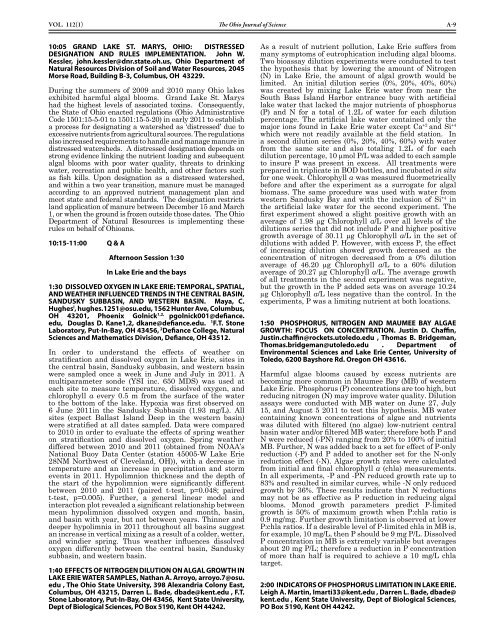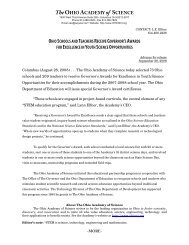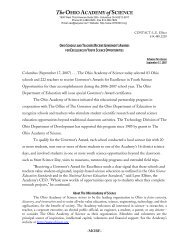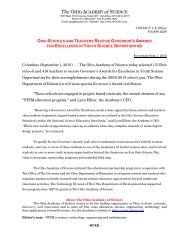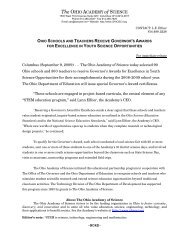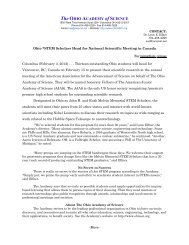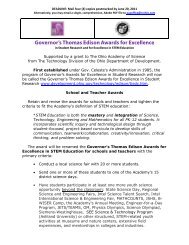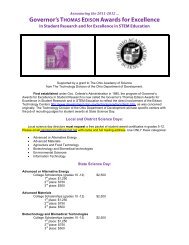The Ohio Journal of - The Ohio Academy of Science
The Ohio Journal of - The Ohio Academy of Science
The Ohio Journal of - The Ohio Academy of Science
You also want an ePaper? Increase the reach of your titles
YUMPU automatically turns print PDFs into web optimized ePapers that Google loves.
Vol. 112(1)<br />
10:05 GRAND LAKE ST. MARYS, OHIO: DISTRESSED<br />
DESIGNATION AND RULES IMPLEMENTATION. John W.<br />
Kessler, john.kessler@dnr.state.oh.us, <strong>Ohio</strong> Department <strong>of</strong><br />
Natural Resources Division <strong>of</strong> Soil and Water Resources, 2045<br />
Morse Road, Building B-3, Columbus, OH 43229.<br />
During the summers <strong>of</strong> 2009 and 2010 many <strong>Ohio</strong> lakes<br />
exhibited harmful algal blooms. Grand Lake St. Marys<br />
had the highest levels <strong>of</strong> associated toxins. Consequently,<br />
the State <strong>of</strong> <strong>Ohio</strong> enacted regulations (<strong>Ohio</strong> Administrative<br />
Code 1501:15-5-01 to 1501:15-5-20) in early 2011 to establish<br />
a process for designating a watershed as ‘distressed’ due to<br />
excessive nutrients from agricultural sources. <strong>The</strong> regulations<br />
also increased requirements to handle and manage manure in<br />
distressed watersheds. A distressed designation depends on<br />
strong evidence linking the nutrient loading and subsequent<br />
algal blooms with poor water quality, threats to drinking<br />
water, recreation and public health, and other factors such<br />
as fish kills. Upon designation as a distressed watershed,<br />
and within a two year transition, manure must be managed<br />
according to an approved nutrient management plan and<br />
meet state and federal standards. <strong>The</strong> designation restricts<br />
land application <strong>of</strong> manure between December 15 and March<br />
1, or when the ground is frozen outside those dates. <strong>The</strong> <strong>Ohio</strong><br />
Department <strong>of</strong> Natural Resources is implementing these<br />
rules on behalf <strong>of</strong> <strong>Ohio</strong>ans.<br />
10:15-11:00 Q & A<br />
Afternoon Session 1:30<br />
In Lake Erie and the bays<br />
1:30 DISSOLVED OXYGEN IN LAKE ERIE: TEMPORAL, SPATIAL,<br />
AND WEATHER INFLUENCED TRENDS IN THE CENTRAL BASIN,<br />
SANDUSKY SUBBASIN, AND WESTERN BASIN. Maya, C.<br />
Hughes l , hughes.1251@osu.edu, 1562 Hunter Ave, Columbus,<br />
OH 43201, Phoenix Golnick 1,2, pgolnick001@defiance.<br />
edu, Douglas D. Kane1,2, dkane@defiance.edu. 1 F.T. Stone<br />
Laboratory, Put-In-Bay, OH 43456, 2 Defiance College, Natural<br />
<strong>Science</strong>s and Mathematics Division, Defiance, OH 43512.<br />
In order to understand the effects <strong>of</strong> weather on<br />
stratification and dissolved oxygen in Lake Erie, sites in<br />
the central basin, Sandusky subbasin, and western basin<br />
were sampled once a week in June and July in 2011. A<br />
multiparameter sonde (YSI inc. 650 MDS) was used at<br />
each site to measure temperature, dissolved oxygen, and<br />
chlorophyll a every 0.5 m from the surface <strong>of</strong> the water<br />
to the bottom <strong>of</strong> the lake. Hypoxia was first observed on<br />
6 June 2011in the Sandusky Subbasin (1.93 mg/L). All<br />
sites (expect Ballast Island Deep in the western basin)<br />
were stratified at all dates sampled. Data were compared<br />
to 2010 in order to evaluate the effects <strong>of</strong> spring weather<br />
on stratification and dissolved oxygen. Spring weather<br />
differed between 2010 and 2011 (obtained from NOAA’s<br />
National Buoy Data Center (station 45005-W Lake Erie<br />
28NM Northwest <strong>of</strong> Cleveland, OH)), with a decrease in<br />
temperature and an increase in precipitation and storm<br />
events in 2011. Hypolimnion thickness and the depth <strong>of</strong><br />
the start <strong>of</strong> the hypolimnion were significantly different<br />
between 2010 and 2011 (paired t-test, p=0.048; paired<br />
t-test, p=0.005). Further, a general linear model and<br />
interaction plot revealed a significant relationship between<br />
mean hypolimnion dissolved oxygen and month, basin,<br />
and basin with year, but not between years. Thinner and<br />
deeper hypolimnia in 2011 throughout all basins suggest<br />
an increase in vertical mixing as a result <strong>of</strong> a colder, wetter,<br />
and windier spring. Thus weather influences dissolved<br />
oxygen differently between the central basin, Sandusky<br />
subbasin, and western basin.<br />
1:40 EFFECTS OF NITROGEN DILUTION ON ALGAL GROWTH IN<br />
LAKE ERIE WATER SAMPLES, Nathan A. Arroyo, arroyo.7@osu.<br />
edu , <strong>The</strong> <strong>Ohio</strong> State University, 398 Alexandria Colony East,<br />
Columbus, OH 43215, Darren L. Bade, dbade@kent.edu , F.T.<br />
Stone Laboratory, Put-In-Bay, OH 43456, Kent State University,<br />
Dept <strong>of</strong> Biological <strong>Science</strong>s, PO Box 5190, Kent OH 44242.<br />
<strong>The</strong> <strong>Ohio</strong> <strong>Journal</strong> <strong>of</strong> <strong>Science</strong> A-9<br />
As a result <strong>of</strong> nutrient pollution, Lake Erie suffers from<br />
many symptoms <strong>of</strong> eutrophication including algal blooms.<br />
Two bioassay dilution experiments were conducted to test<br />
the hypothesis that by lowering the amount <strong>of</strong> Nitrogen<br />
(N) in Lake Erie, the amount <strong>of</strong> algal growth would be<br />
limited. An initial dilution series (0%, 20%, 40%, 60%)<br />
was created by mixing Lake Erie water from near the<br />
South Bass Island Harbor entrance buoy with artificial<br />
lake water that lacked the major nutrients <strong>of</strong> phosphorus<br />
(P) and N for a total <strong>of</strong> 1.2L <strong>of</strong> water for each dilution<br />
percentage. <strong>The</strong> artificial lake water contained only the<br />
major ions found in Lake Erie water except Ca +2 and Si +4<br />
which were not readily available at the field station. In<br />
a second dilution series (0%, 20%, 40%, 60%) with water<br />
from the same site and also totaling 1.2L <strong>of</strong> for each<br />
dilution percentage, 10 µmol P/L was added to each sample<br />
to insure P was present in excess. All treatments were<br />
prepared in triplicate in BOD bottles, and incubated in situ<br />
for one week. Chlorophyll a was measured fluormetrically<br />
before and after the experiment as a surrogate for algal<br />
biomass. <strong>The</strong> same procedure was used with water from<br />
western Sandusky Bay and with the inclusion <strong>of</strong> Si +4 in<br />
the artificial lake water for the second experiment. <strong>The</strong><br />
first experiment showed a slight positive growth with an<br />
average <strong>of</strong> 1.98 µg Chlorophyll a/L over all levels <strong>of</strong> the<br />
dilutions series that did not include P and higher positive<br />
growth average <strong>of</strong> 30.11 µg Chlorophyll a/L in the set <strong>of</strong><br />
dilutions with added P. However, with excess P, the effect<br />
<strong>of</strong> increasing dilution showed growth decreased as the<br />
concentration <strong>of</strong> nitrogen decreased from a 0% dilution<br />
average <strong>of</strong> 46.20 µg Chlorophyll a/L to a 60% dilution<br />
average <strong>of</strong> 20.27 µg Chlorophyll a/L. <strong>The</strong> average growth<br />
<strong>of</strong> all treatments in the second experiment was negative,<br />
but the growth in the P added sets was on average 10.24<br />
µg Chlorophyll a/L less negative than the control. In the<br />
experiments, P was a limiting nutrient at both locations.<br />
1:50 PHOSPHORUS, NITROGEN AND MAUMEE BAY ALGAE<br />
GROWTH: FOCUS ON CONCENTRATION. Justin D. Chaffin,<br />
Justin.chaffin@rockets.utoledo.edu , Thomas B. Bridgeman,<br />
Thomas.bridgeman@utoledo.edu . Department <strong>of</strong><br />
Environmental <strong>Science</strong>s and Lake Erie Center, University <strong>of</strong><br />
Toledo, 6200 Bayshore Rd. Oregon OH 43616.<br />
Harmful algae blooms caused by excess nutrients are<br />
becoming more common in Maumee Bay (MB) <strong>of</strong> western<br />
Lake Erie. Phosphorus (P) concentrations are too high, but<br />
reducing nitrogen (N) may improve water quality. Dilution<br />
assays were conducted with MB water on June 27, July<br />
15, and August 5 2011 to test this hypothesis. MB water<br />
containing known concentrations <strong>of</strong> algae and nutrients<br />
was diluted with filtered (no algae) low-nutrient central<br />
basin water and/or filtered MB water; therefore both P and<br />
N were reduced (-PN) ranging from 20% to 100% <strong>of</strong> initial<br />
MB. Further, N was added back to a set for effect <strong>of</strong> P-only<br />
reduction (-P) and P added to another set for the N-only<br />
reduction effect (-N). Algae growth rates were calculated<br />
from initial and final chlorophyll a (chla) measurements.<br />
In all experiments, -P and -PN reduced growth rate up to<br />
83% and resulted in similar curves, while -N only reduced<br />
growth by 36%. <strong>The</strong>se results indicate that N reductions<br />
may not be as effective as P reduction in reducing algal<br />
blooms. Monod growth parameters predict P-limited<br />
growth is 50% <strong>of</strong> maximum growth when P:chla ratio is<br />
0.9 mg/mg. Further growth limitation is observed at lower<br />
P:chla ratios. If a desirable level <strong>of</strong> P-limited chla in MB is,<br />
for example, 10 mg/L, then P should be 9 mg P/L. Dissolved<br />
P concentration in MB is extremely variable but averages<br />
about 20 mg P/L; therefore a reduction in P concentration<br />
<strong>of</strong> more than half is required to achieve a 10 mg/L chla<br />
target.<br />
2:00 INDICATORS OF PHOSPHORUS LIMITATION IN LAKE ERIE.<br />
Leigh A. Martin, Imarti33@kent.edu , Darren L. Bade, dbade@<br />
kent.edu , Kent State University, Dept <strong>of</strong> Biological <strong>Science</strong>s,<br />
PO Box 5190, Kent OH 44242.


